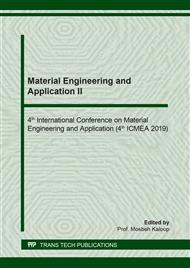p.54
p.59
p.64
p.70
p.76
p.82
p.87
p.94
p.99
Studying the Stability and Conductivity of the Composite Films via Electrospinning/Spray Process
Abstract:
The electrospinning/spray technique is a promising approach to fabricate composite films for many applications in flexible electronic devices. In this study, an elastic film with remarkable conductivity is synthesized by electrospinning TPU (thermoplastic polyurethanes) fibers and electrospraying graphene nanosheets into the single collector. This technique allows the graphene nanosheets to adhere uniformly to a carbon textile matrix for promoting its conductivity. But the graphene is possible to be oxidized into graphene oxide during electrospray, which is attributed to the high-voltage field, the rapid evaporation of the solvent and the full exposure to air. And the spinning fibers have the potential to induce the behavior as well. The instability of graphene during the process can make an impact on the overall conductivity and uniformity of composite films. So, we set up a series of experiments on the study of oxidization behavior of graphene and its influence on the performance of composite films. With different parameters, some samples are synthesized to conduct Raman spectroscopy analysis as well as take the measurements of overall conductivity through a 4-point probe electrical conductivity device. The oxidization behavior of graphene during the electrospinning/spray process can be well characterized by the results from the Raman spectrums. And the results of electrical conductivity measurements can provide powerful evidence to ensure the great conductivity of composite films via electrospinning/spray process.
Info:
Periodical:
Pages:
76-81
Citation:
Online since:
May 2020
Authors:
Keywords:
Price:
Сopyright:
© 2020 Trans Tech Publications Ltd. All Rights Reserved
Share:
Citation:


